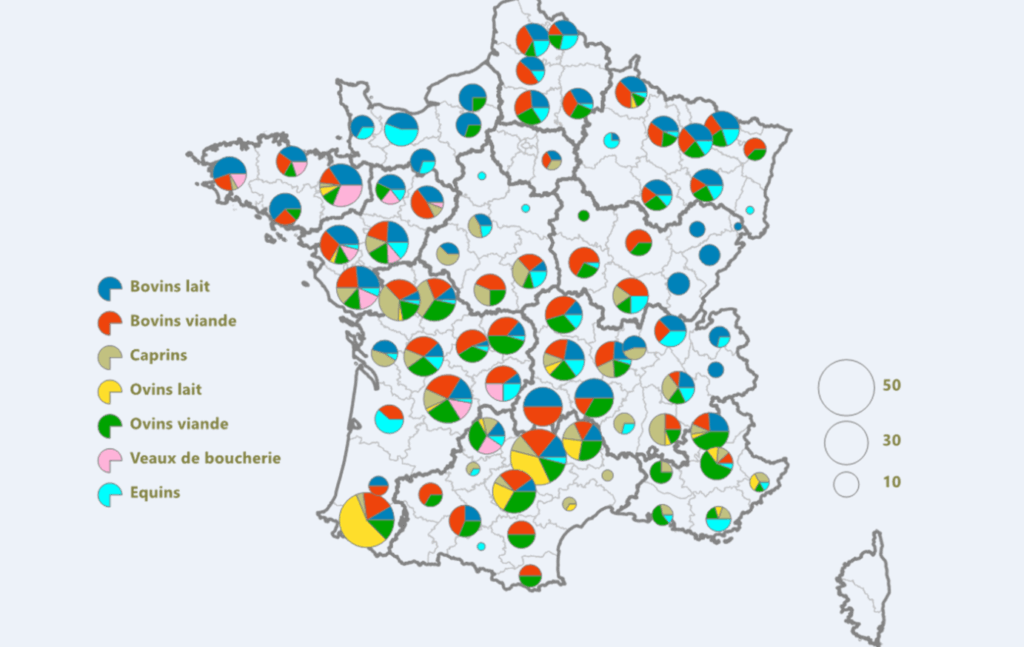Livestock farming is facing a convergence of transitions: agroecology, climate adaptation, economic resilience, societal expectations, and farmer well-being. Supporting these changes requires robust systems for observation, innovation, and advisory services.
In France, the INOSYS Livestock Networks (INOSYS Réseaux d’élevage) provide such a system. Built on co-construction of knowledge and systemic analysis of farms, INOSYS has monitored livestock systems for decades, delivering technical, economic, environmental, and social benchmarks to guide transition pathways.
Origins and Development
A response to systemic challenges
Created in the early 1980s, the Livestock Networks emerged when agricultural development was still dominated by intensification and input use. While these strategies boosted production, they raised sustainability concerns. Farmers and advisors, inspired by local development groups (CETA, GVA), began co-producing knowledge with technical institutes and Chambers of Agriculture.
From benchmarks to strategic tools
Initially focused on building technical and economic references, the networks soon evolved to cover adaptation to policy reforms, crises (BSE, market shocks), and climate variability. Over time, they developed “typical farm models”, reconstructed farm systems that reflect realistic economic, social, and environmental outcomes.
A unique long-term investment
Although resource-intensive, INOSYS represents a strategic investment: it strengthens advisory staff expertise, supports transitions, and produces collective references widely used by farmers, advisors, policymakers, and researchers.
How the System Operates
Multi-level structure
INOSYS is organised by sector (dairy, beef, sheep, goats, veal, equines) and territory. It monitors 1,500 reference farms, supported by 190 advisors from Chambers of Agriculture and 30 IDELE engineers. Farms are selected based on representativeness, performance, and willingness to share data.
Shared governance
The system relies on a partnership between the Chamber of Agriculture of France (field expertise and local anchoring) and the French Livestock Institute IDELE (national technical expertise and methodology). Farmers, advisors, engineers, researchers, and professional organisations co-create knowledge and rules.
What is produced and shared
- Technical & economic syntheses by system and region
- Thematic reports (e.g., energy, forage, milking robots)
- Annual income forecasts
- Farm monographs & farmer portraits
- Price guides & dashboards
- Typical farm models (cas-type), used for simulation, R&D, and policy support
All outputs are freely accessible via a dedicated portal (>250 models), IDELE and Chamber of Agriculture websites, and social media.
Supporting Advisory Services and Transitions
Helping advisors face complexity
Advisors must deal with diverse missions (regulations, technical optimisation, strategic choices) under time and expertise constraints. INOSYS provides robust benchmarks that secure advice and inform both short-term decisions (e.g., regulatory compliance) and long-term strategies (e.g., diversification, organic conversion).
Tools derived from INOSYS data
- COUPROD: calculates production costs and profitability.
- SIMULBOX, DECIBOV, OVIPLAN: simulators for system evolution
- CAP’2ER: evaluates GHG emissions and carbon storage.
- Déclic Travail: assesses work organisation and quality of life
- Self’Agri: energy performance diagnostic
These tools translate raw data into practical decision-support instruments.
Thematic Networks: Innovating for the Future
Since 2022, 18 Thematic Networks (TNs) have been launched to address emerging challenges beyond representative farms. They act as innovation incubators, observing about 10 pioneering systems each.
Themes include:
- Climate adaptation
- Feed & protein autonomy
- Towards carbon neutrality
- Local marketing of dairy and meat products
- Bold farm installation models
- High-tech & smart farming
- Organic systems, grazing strategies, predation challenges, etc.
These TNs foster cross-sectoral and interregional exchanges, linking observation to practical advisory tools on work organisation, feed autonomy, and environmental performance.
Recognition and Impact
Adoption and legitimacy
A 2024 survey of 1,000 agricultural stakeholders showed:
- 86% know INOSYS
- 95% find its data useful for work
INOSYS references are widely used in R&D, education, foresight, and policy (e.g., CAP reform simulations, ecological planning).
Challenges
Two barriers remain:
- Methodological complexity, which may deter non-specialists
- Limited awareness beyond core networks
To address this, INOSYS has strengthened dissemination via webinars, 150 annual publications, and active social media outreach. The INOSYS website now reaches 240,000 page views (2025).
Conclusion: INOSYS as a Model for Transition
INOSYS shows how advisory systems are being reinvented: more participatory, systemic, and interdisciplinary. Its long-term monitoring, shared governance, and innovative tools make it a cornerstone for supporting sustainable, resilient, and viable farming systems.
Beyond livestock, the INOSYS model now inspires other sectors (arable crops, poultry, rabbits, viticulture), showing its potential as a template for multi-stakeholder knowledge systems.




